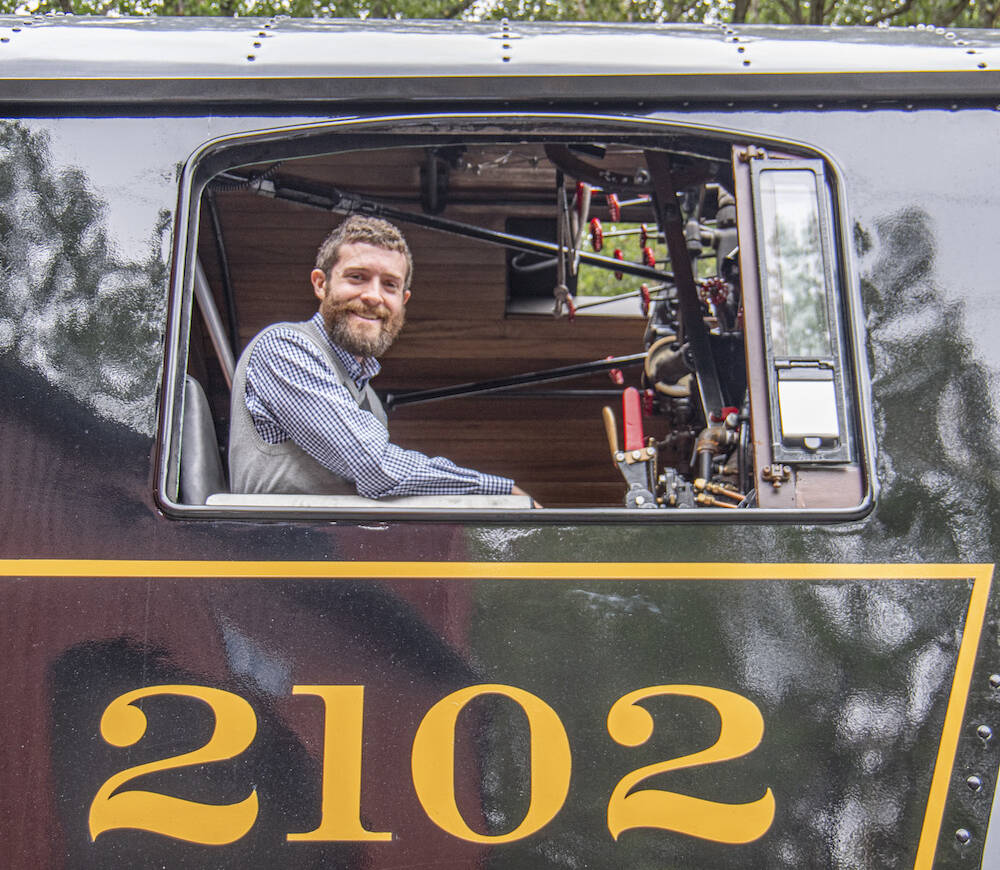
Everyone has a story worth sharing. Nick Ozorak uses that as a guiding philosophy for his digital media and marketing agency, Streamliner Media, as well as his railroading podcast, The Roundhouse. Streamliner Media produces high-quality videos for the freight and rail preservation industries, with clients ranging from the Iowa Interstate Railroad to the East Broad Top Railroad. The Roundhouse serves as a platform for discussing a wide range of topics and documenting individual stories – including former Norfolk Southern CEO Wick Moorman and Rocky Mountain Express IMAX Director Stephen Low as featured guests – with a plethora of content surrounding the preservation scene.
How did you get involved in rail preservation?
Nick Ozorak: Credit to my dad, I’ve been a lifelong railfan, but what started as a means of bonding with him became my own passion, thanks in part to train simulators. This new technology that came onto the scene in the early 2000s could transport you anywhere in the world at any point in time and give you a sense of what different railroads were like. My first foray into trying to convey those stories was a YouTube series called At the Railyard, where I reviewed train simulator products, with an eye toward explaining the history and technology.
As I was getting further into exploring more of the real-life history beyond what the train simulators represented, I realized that it would be great to hear the stories directly from those who had the experience. Hosting The Roundhouse podcast – to both hear and explore these stories – has been a great deal of fun since I began the show in 2015. It was through these interviews that I further refined my understanding of storytelling and how to embrace a larger audience.
In December 2020, I combined my filmmaking background and my railroading knowledge into Streamliner Media. Creating digital content, especially videos, for clients requires that I learn what their stories are and what goals they are seeking to accomplish by sharing them. I have learned a tremendous amount of what goes on behind the scenes due to this work.
As a young preservationist at age 32, what have you found to be the most challenging aspects of the industry?
Nick Ozorak: For a lot of us in rail preservation, we get so caught up in our specific organization and specific needs that we forget to view what is happening in a larger context. I’ve always been a very big-picture thinker, so I feel I have something to contribute there, but I also learn a great deal from those who specialize in specific fields. My goal is to continuously find the place where these two perspectives meet. The more that we can simultaneously consider the bigger picture and determine what needs to be done at this specific moment, the more these efforts will ultimately help us with our individual and organizational needs.
I also find myself in this interesting space with the podcast where I’m always looking at it and asking, “What needs to be accomplished at this particular moment?” I respect the platform’s power, which is why I have used it to shine a spotlight on difficult subjects such as sexism and succession planning. I try to pay attention to where the conversation is nationally, what themes are emerging across organizations, and how to address them in a way that moves us forward. There are conversations about problems in the industry that need to be discussed in a manner that isn’t about placing blame but instead answering why these systemic issues exist and how to address them.
What’s been most rewarding for you so far?
Nick Ozorak: I meet the most fascinating people through my work. So often when I ask my guests on The Roundhouse, “What do you appreciate most about what you do?” Almost every time the answer is, “The people I work with.” And I think that part of where we hopefully see the conversations continue is by looking at the people. We all sometimes get a little too fixated on the machines, but the machines wouldn’t be there if it weren’t for the people. I also count myself fortunate to have made so many great friends and to have so many great connections through the industry and hobby.
Where do you see rail preservation as it is today, and what do you hope it’ll become in the future?
Nick Ozorak: It’s great to see how people have bonded through the internet in ways that sometimes lead to the creation of formal organizations, the saving of equipment, and informal groups where people exchange ideas like “Ahead of the Torch” on Facebook. I am collaborating with a team on Next Generation Railroaders, a new nonprofit organization that will bridge equipment, geographical borders, and interests centered around engaging youth. The goal is to harness the energy of young railfans, bring them into preservation, and educate them to strengthen both themselves and these organizations. I look forward to sharing more information about this with your readers as we make progress.
What advice would you give to any young person looking to get involved in the industry?
Nick Ozorak: Network. Talk to people. Talk to those that others say you should talk to, get to know them, and ask questions. We all could feel a little shy, but it’s overcoming that and asking, “Hey, what can you tell me?” The more people you talk to, the more things can happen on a whole host of fronts.









